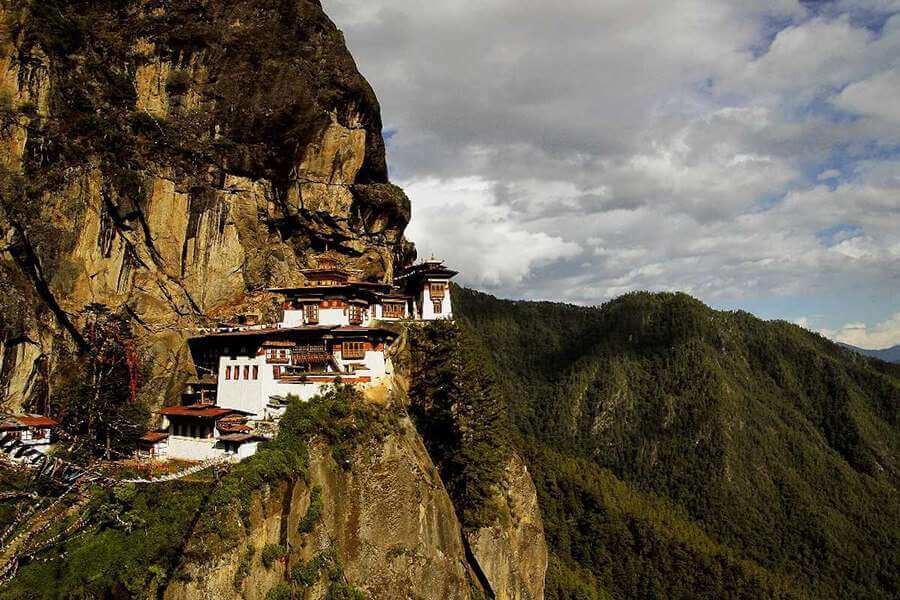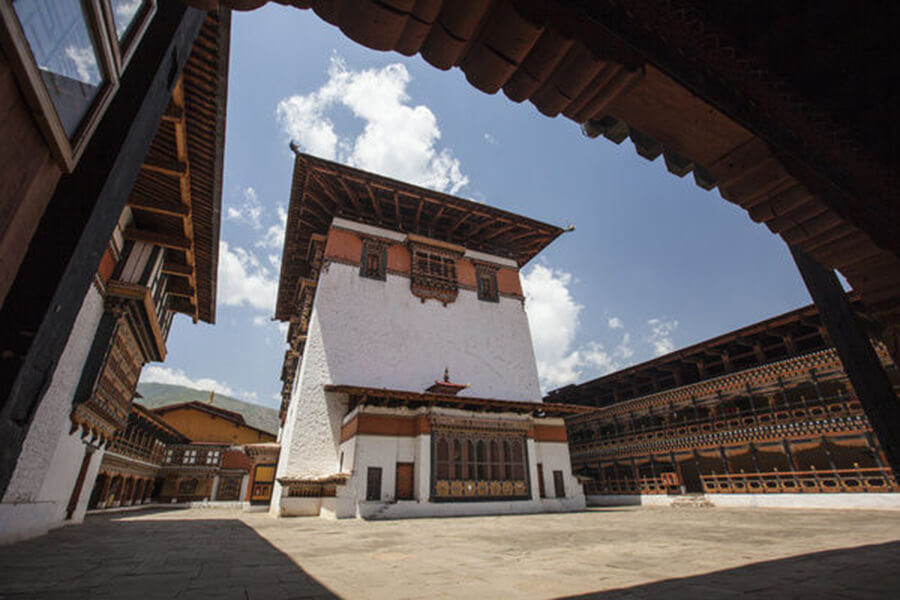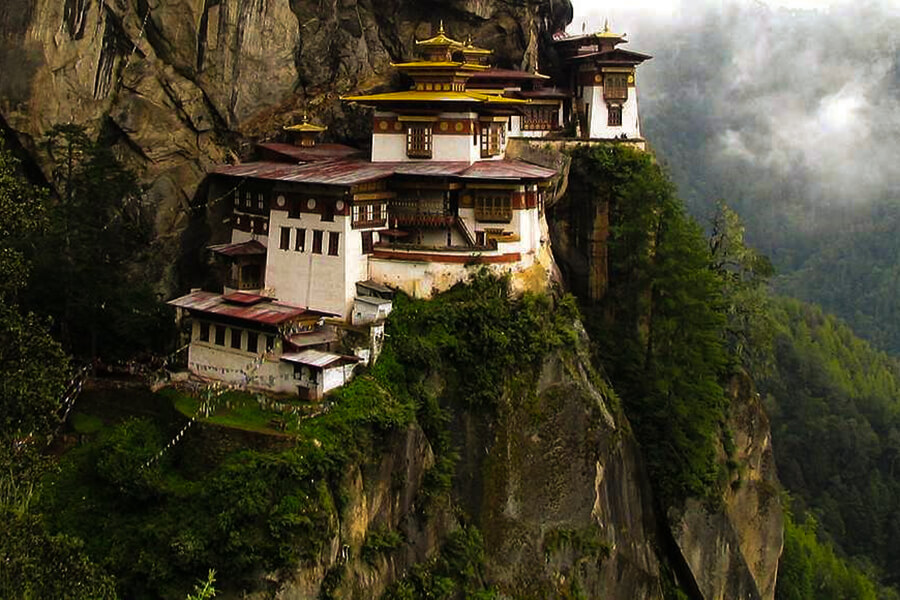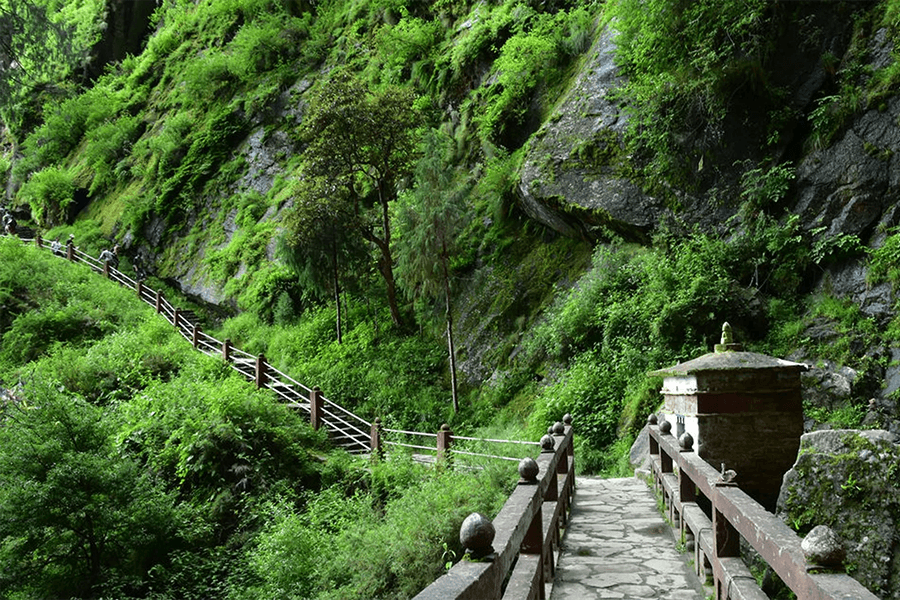Tiger's Nest Monastery | The Most Sacred Place In Bhutan
Tiger's Nest Monastery (roughly translated as "Tiger's Nest Monastery"), or Paro Taktsang, is one of the most prominent Buddhist sites in Bhutan. This is a famous Buddhist site in the Himalayas, attracting a large number of tourists from all over to worship.
Location & Topography of Taktsang Monastery Perched 900 meters above the cliffs and 3120 meters above sea level above in the Paro Valley, this monastery is certainly an architectural wonder. While Bhutan has many monasteries, what makes Paro Taktsang stand out is its religious and historical significance. With a total distance of 6.4 km, this trek offers mesmerizing views of the Paro Valley. The mystery of how it was built in such conditions still amazes people. This is one of the few places in Bhutan visited by Guru Rinpoche, who is also known as the 'Second Buddha'.
Perched 900 meters above the cliffs and 3120 meters above sea level above in the Paro Valley, this monastery is certainly an architectural wonder. While Bhutan has many monasteries, what makes Paro Taktsang stand out is its religious and historical significance. With a total distance of 6.4 km, this trek offers mesmerizing views of the Paro Valley. The mystery of how it was built in such conditions still amazes people. This is one of the few places in Bhutan visited by Guru Rinpoche, who is also known as the 'Second Buddha'.
Visiting Paro Taktsang Monastery is an unforgettable experience thanks to its unique location and views of the surrounding majestic mountains and emerald green valleys. The main peculiarity of the monastery is its isolated location. It can only be reached by mountain roads. The remote location of the monastery makes it amazingly beautiful and unique, but also poses technical difficulties.  No wonder, when you are looking at the Taktsang Palphug monastery from the Paro valley or from the bottom of the cliff, it seems impossible to reach the Tiger's Nest Monastery.
No wonder, when you are looking at the Taktsang Palphug monastery from the Paro valley or from the bottom of the cliff, it seems impossible to reach the Tiger's Nest Monastery.
Legend of Tiger's Nest Monastery
According to Bhutanese legend, in the 8th century Master Padmasambhava rode on the back of a flaming tiger from Tibet to Paro Taktsang temple and meditated there for 3 years 3 months 3 weeks 3 days 3 hour. Padmakāra was the one who introduced Esoteric Buddhism to Bhutan and Tibet in the years 700 BC.
The name “Taktsang” in Bhutanese means “Tiger Cave” and was originated when locals encountered a female tiger residing in one of the caves. The Bhutanese people believe that at that time Master Padmasambhava transformed into the fire Dorje Drolo (one of his eight images) and the tiger was his wife Yeshe Tsogyal, incarnated to protect and subdue him. Evil spirits here. It is believed that Master Padmasambhava meditated in the mountain cave for 3 years, 3 months, 3 weeks, 3 days and 3 hours. After completing the meditation, Master Padmasambhava subdued eight types of evil spirits and converted the Bhutanese people to Buddhism. Today, he is considered as sacred as Buddha himself and is considered the second Buddha and guardian deity of Bhutan. His followers believe that Guru Padmasambhava is still alive and active but in a different form.
It is believed that Master Padmasambhava meditated in the mountain cave for 3 years, 3 months, 3 weeks, 3 days and 3 hours. After completing the meditation, Master Padmasambhava subdued eight types of evil spirits and converted the Bhutanese people to Buddhism. Today, he is considered as sacred as Buddha himself and is considered the second Buddha and guardian deity of Bhutan. His followers believe that Guru Padmasambhava is still alive and active but in a different form.
Paro Taktsang Monastery was built around the Taktsang Senge Samdup cave, where Padmasambhava is said to have meditated when he came to meditate at Paro Taktsang. In 853, Langchen Pelkyi Singye came to the cave to Meditate and gave his Pelphug name to the cave – “Pelkyi’s cave”. After his death in Nepal, Master Pelkyi's body is said to have been miraculously brought back to the monastery by the grace of Deity Dorje Legpa. Since the 11th century, many Tibetan Saints and famous figures have come here to meditate, among them is Milarepa - a famous master of Himalayan Buddhism.
From the 12th to 17th centuries many lamas from Tibet established monasteries in Bhutan. The first sanctuary built in the area dates back to the 14th century when Sonam Gyeltshen, a Nyingmapa lama of the Kathogpa branch arrived from Tibet.
Architecture of Tiger's Nest Monastery
In the seventh century, when Guru Padmasambhava introduced Buddhism to Bhutan, he rode a tiger on his way back to Tibet to this location. In the cave, he meditated continuously for three months. Local demons and evil spirits were subdued by him. This is how the monastery got its name Tiger's Nest Monastery. Paro Taktsang is said to be blessed by Guru Rinpoche and the mesmerizing surroundings make the hike worthwhile.
Built on a steep cliff in an isolated location, the fact of how a monastery as beautiful as this one could be built so flawlessly in such a location baffles everyone. hard to understand. People from all over the world visit Paro Taktsang to see Bhutan's beautiful architecture. There are three major temples found here and the best part is the cave where Guru Rinpoche meditated. Many in there can still feel his presence. The walls are painted with holy images of Padmasambhava, all very beautiful and intricate. The trail starts from the nearest road and the total length up to the monastery is about 4 km. There are colorful flags along the path, making the trail beautiful and colorful. The first stop on the route is a cafe, 2 km uphill from the car park. The trail is gentle, with a great view along the way. This is more of a resting spot where you can relax and treat yourself to snacks and tea to complete the 2km trek.
The trail starts from the nearest road and the total length up to the monastery is about 4 km. There are colorful flags along the path, making the trail beautiful and colorful. The first stop on the route is a cafe, 2 km uphill from the car park. The trail is gentle, with a great view along the way. This is more of a resting spot where you can relax and treat yourself to snacks and tea to complete the 2km trek.
Then there's a 1.44km hike to a cliff from where the best views of Paro Taktsang are. Here, the monastery looks as it should. It looks like a paradise nestled among the hills and the aura is extremely charming and tranquil. From this point, the monastery is only 0.6 km away. The journey seems impossible to complete, but when you reach the monastery's entrance gate and the wonderful view that greets you, the feeling of fatigue will disappear in seconds.
The outstanding event of this Taktsang monastery is that on April 19, 1998, a fire started in the Monastery, it was completely burned down: the temple was difficult to reach and emergency assistance was not possible .
The first is a trail that passes through a pine forest and is decorated with bright prayer bannerettes, symbolizing protection from evil forces, positive energy, vitality and luck. The remaining two roads go through the plateau, called "the plateau of a hundred thousand fairies".  The craggy location of the complex reminds people of the image of a gecko clinging to a mountainside. There are no vehicles going up to Tiger's Nest Monastery because the road is not well laid out. So walking remains the only viable option.
The craggy location of the complex reminds people of the image of a gecko clinging to a mountainside. There are no vehicles going up to Tiger's Nest Monastery because the road is not well laid out. So walking remains the only viable option. The walk from the nearest road lasts between four and six hours, depending on your pace. Animals such as ponies can also be hired at the base to the midpoint from which you have to walk a bit to reach the top. But due to the winding trail, the trip becomes risky and tiring, because animals collide a lot. Therefore, walking is the best option to reach the monastery.
The walk from the nearest road lasts between four and six hours, depending on your pace. Animals such as ponies can also be hired at the base to the midpoint from which you have to walk a bit to reach the top. But due to the winding trail, the trip becomes risky and tiring, because animals collide a lot. Therefore, walking is the best option to reach the monastery.











![[LIVE] Engage2Earn: Shayne is helping koalas!](https://cdn.bulbapp.io/frontend/images/08e2e573-f490-4ef4-93b6-f2285814da59/1)
































